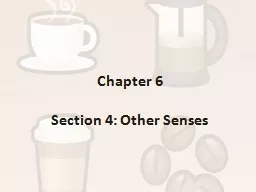

Taste Savory Sensations Taste occurs because chemicals stimulate thousands of receptors in the mouth primarily on the tongue but also in the throat cheeks amp roof of mouth Papillae Knoblike elevations on the tongue containing the taste buds ID: 779077
Download The PPT/PDF document "Chapter 6 Section 4: Other Senses" is the property of its rightful owner. Permission is granted to download and print the materials on this web site for personal, non-commercial use only, and to display it on your personal computer provided you do not modify the materials and that you retain all copyright notices contained in the materials. By downloading content from our website, you accept the terms of this agreement.
Slide1
Chapter 6
Section 4: Other Senses
Slide2Taste: Savory Sensations
Taste
occurs because chemicals stimulate thousands of receptors in the mouth, primarily on the tongue, but also in the throat, cheeks, & roof of mouth
Slide3Papillae: Knoblike elevations on the tongue, containing the taste buds
Slide4Actual receptors for taste are inside the taste buds
Cells send tiny fibers out through an opening in the bud
Receptor cells are replaced by new cells every ten days
After 40, total number of taste buds declines
Slide5Bitterness & sourness help us identify foods that are rancid or poisonous
Sweetness helps us identify foods that are healthful or rich in calories
Salt is necessary for all bodily functions
Slide6Basic tastes can be perceived at any spot on the tongue
Center has no taste buds
Taste differences are genetic, a matter of culture & learning
Attractiveness of a food can also be affected by its color, temperature, texture, & odor
Slide7Smell: The Sense of Scents
Smell or olfaction
Slide8Airborne chemical molecules enter the nose & circulate through the nasal cavity.
Vapors can also enter through the mouth & pass into nasal cavity.
Slide9Sniff out dangers by smelling smoke, food spoilage, & poisonous gases
Loss can be caused by infection, disease, injury, or smoking
Slide10Red bars show the people who could identify a substance dropped on the tongue when they were able to smell it
Blue bars show the people who could identify the substance when they were not able to smell it
Slide11Senses of the Skin
Protects our innards, helps identify objects, establish intimacy with others, gives us a sense of ourselves as a distinct from the environment
Basic senses- touch/pressure, warmth, cold, & pain
Tickle, itch, & burning
Slide12The Mystery of Pain
When the stimulus producing it is removed, the sensation may continue, sometimes for years
Chronic pain disrupts lives, puts stress on the body, & causes depression, & despair
Slide13The Gate Control Theory of Pain
Experience of pain depends (in part) on whether the pain impulse gets past neurological “gate” in the spinal cord & thus reaches the brain.
Slide14Brain influences the gate
Thoughts & feelings can influence our reactions to pain
Slide15Updating the Gate Control Theory
Doesn’t explain phantom pain
Brain not only responds to incoming signals from sensory nerves but is also capable of generating pain entirely on its own
A network of neurons in the brain gives us a sense of our own bodies & body parts
Slide16Neuromatrix Theory of Pain
Theory that the matrix of neurons in the brain is capable of generating pain (& other sensations) in the absence of signals from sensory nerves
Slide17The Environment Within
Kinesthesis
: The sense of body position and movement of body parts
Information provided by pain & pressure receptors located in muscles, joints, & tendons
Slide18Equilibrium: The sense of balance
Gives us information about our bodies as a whole
Relies on three semicircular canals in the inner ear
Tubes are filled with fluid that moves & presses on hair like receptors whenever the head rotates
Slide19Receptors intake messages that travel through a part of the auditory nerve not involved in hearing